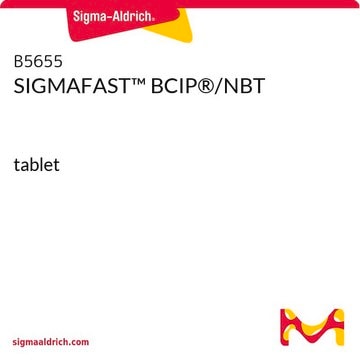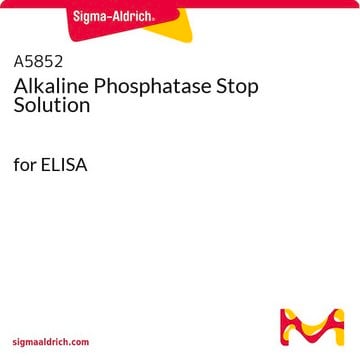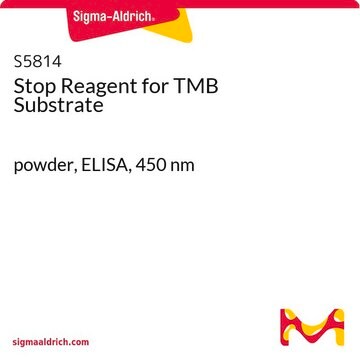AB0100
Alkaline Phosphatase Blue Microwell Substrate
alkaline phosphatase substrate, solution
Synonym(s):
5-bromo-4-chloro-3-indolyl phosphate analog / NBT substrate for microwell assays
Sign Into View Organizational & Contract Pricing
All Photos(1)
About This Item
UNSPSC Code:
12352204
NACRES:
NA.83
Recommended Products
Product Name
Alkaline Phosphatase Blue Microwell Substrate, sufficient for 400 mL working substrate
form
solution
Quality Level
usage
sufficient for 400 mL working substrate
storage temp.
2-8°C
Looking for similar products? Visit Product Comparison Guide
General description
Alkaline phosphatase blue microwell substrate, a two-component mixture develops a bluish-purple product when reacted with alkaline phosphatase in microwell type assays. This substrate is not recommended for membrane or immunohistochemical type assays that require an insoluble reaction product.
Application
Prior to reaction with alkaline phosphatase, the BCIP® reagent is colorless to faint blue solution, and the Nitro BT reagent is a yellow solution. The two component mixture develops a bluish-purple product when reacted with alkaline phosphatase in microwell type assays. This substrate is not recommended for membrane or immunohistochemical type assays that require a precipitation reaction product.
Physical form
A 2 component kit sufficient for preparing 400 mL of working substrate.
Supplied as a 2 component buffered alkaline phosphatase substrate containing Bromo-Chloro-Indolylphosphate (BCIP) and Nitro Blue Tetrazolium (NBT/Thiazolyl Blue/Nitro BT)
Legal Information
BCIP is a registered trademark of Merck KGaA, Darmstadt, Germany
Storage Class Code
10 - Combustible liquids
Choose from one of the most recent versions:
Already Own This Product?
Find documentation for the products that you have recently purchased in the Document Library.
Customers Also Viewed
Debojyoti Chakraborty et al.
Cell reports, 21(11), 3012-3021 (2017-12-16)
Long noncoding RNAs (lncRNAs) have been implicated in diverse biological processes, including embryonic stem cell (ESC) maintenance. However, their functional mechanisms remain largely undefined. Here, we show that the lncRNA Panct1 regulates the transient recruitment of a putative X-chromosome-encoded protein
Sebastiano Giallongo et al.
Stem cells (Dayton, Ohio), 40(1), 35-48 (2022-05-06)
DNA damage repair (DDR) is a safeguard for genome integrity maintenance. Increasing DDR efficiency could increase the yield of induced pluripotent stem cells (iPSC) upon reprogramming from somatic cells. The epigenetic mechanisms governing DDR during iPSC reprogramming are not completely
Tandrima Mitra et al.
Mutation research, 832-833, 41-51 (2018-07-31)
The present study was undertaken to investigate the alterations in gene expression patterns and for mutation analysis of p53 in the riverine catfish Rita rita collected from polluted riverine habitat. The partial p53 gene sequence of Rita rita generated showed
Sarka Jelinkova et al.
Stem cell research, 40, 101562-101562 (2019-09-19)
Duchenne muscular dystrophy (DMD) affects 1:3500-5000 newborn boys and manifests with progressive skeletal muscle wasting, respiratory failure and eventual heart failure. Symptoms show different onset from patients' childhood to the second decade of age. We reprogrammed fibroblasts from two independent
Overexpression screen of chromosome 21 genes reveals modulators of Sonic hedgehog signaling relevant to Down syndrome.
Moyer, et al.
Disease models & mechanisms, 16 (2023)
Our team of scientists has experience in all areas of research including Life Science, Material Science, Chemical Synthesis, Chromatography, Analytical and many others.
Contact Technical Service












